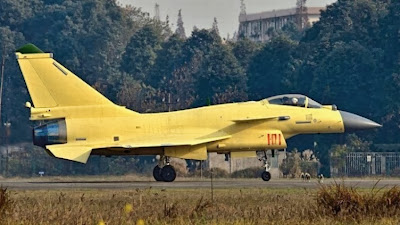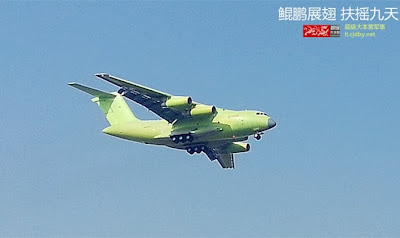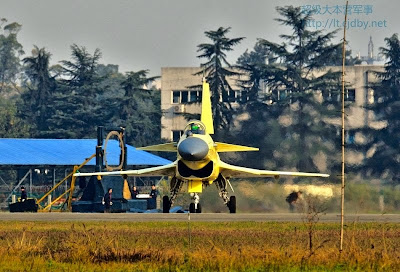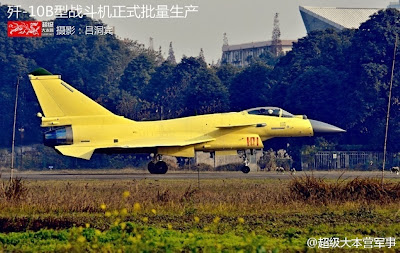In the year 2013 many of China's new military aviation projects appeared, so it was very exciting for all the followers of the PLAAF . Although there weren't as many news coming out this year about J-20 and J-31 stealth fighters, many other projects really came out and took center stage.
Y-20 - Although we started see pictures of Y-20 performing low speed taxiing late last year, it did not make it's maiden flight until late January of this year. The second Y-20 prototype made its maiden flight very recently. It looks like this program is progressing well so far. PLAAF is desperate for something like Y-20 to not only do the role of strategic transport but also as the platform for next generation AWACS (and other C4ISR roles), large aerial tanker and airborne laser platform. It has been forced to purchase a number of refurbished IL-76s from Russia in the past couple of years as a stop gap until Y-20 comes into service in 3 to 5 years. I think there is a chance that they will also purchase some new built IL-476 since the production rate for Y-20 is likely to be low in the beginning. In my opinion, this is the most important aviation project for PLA.
J-20/J-31 - It has been a less eventful year for the 5th generation projects. Many of us expect the prototype 2003 to come out this year, but we were disappointed for most of the year (although there is some recent photo that indicate 2003 might be ready). It looks like major improvements are to be made in this third prototype, whereas the first 2 are probably more like technology demonstrators. J-31 has been making some more test flights, but it's not known at the moment what exact role it will have for PLAAF. Similar to J-20, this first prototype is probably more like a technology demonstrator while 601 Institute works on creating a prototype that satisifies all of PLAAF requirements.
Flanker family - While rumours about Su-35 purchase continues unabated, we do know that J-15 project has moved to production stage this year. We are still waiting to see production version of J-15 to appear on CV-16. That will probably happen next year. It looks like J-16 project is also moving toward a first pre-production batch. J-11B/S production has continued this year, but will probably be replaced by J-16 very soon. At which point, J-15 will be produced for the naval aviation and J-16 will be for the air force. J-16 and J-10B are likely to be the main multirole fighters in PLAAF until the 5th generation aircraft enters service.
Y-20 - Although we started see pictures of Y-20 performing low speed taxiing late last year, it did not make it's maiden flight until late January of this year. The second Y-20 prototype made its maiden flight very recently. It looks like this program is progressing well so far. PLAAF is desperate for something like Y-20 to not only do the role of strategic transport but also as the platform for next generation AWACS (and other C4ISR roles), large aerial tanker and airborne laser platform. It has been forced to purchase a number of refurbished IL-76s from Russia in the past couple of years as a stop gap until Y-20 comes into service in 3 to 5 years. I think there is a chance that they will also purchase some new built IL-476 since the production rate for Y-20 is likely to be low in the beginning. In my opinion, this is the most important aviation project for PLA.
J-20/J-31 - It has been a less eventful year for the 5th generation projects. Many of us expect the prototype 2003 to come out this year, but we were disappointed for most of the year (although there is some recent photo that indicate 2003 might be ready). It looks like major improvements are to be made in this third prototype, whereas the first 2 are probably more like technology demonstrators. J-31 has been making some more test flights, but it's not known at the moment what exact role it will have for PLAAF. Similar to J-20, this first prototype is probably more like a technology demonstrator while 601 Institute works on creating a prototype that satisifies all of PLAAF requirements.
Flanker family - While rumours about Su-35 purchase continues unabated, we do know that J-15 project has moved to production stage this year. We are still waiting to see production version of J-15 to appear on CV-16. That will probably happen next year. It looks like J-16 project is also moving toward a first pre-production batch. J-11B/S production has continued this year, but will probably be replaced by J-16 very soon. At which point, J-15 will be produced for the naval aviation and J-16 will be for the air force. J-16 and J-10B are likely to be the main multirole fighters in PLAAF until the 5th generation aircraft enters service.













